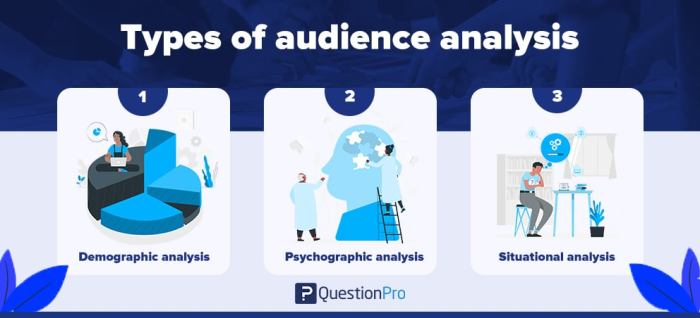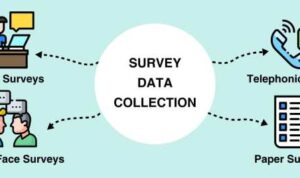Kicking off with Understanding Audience Psychographics, get ready to dive into the fascinating world of consumer behavior and preferences. From analyzing psychographics to implementing tailored marketing strategies, this topic is all about understanding your audience on a deeper level.
Stay tuned as we explore the key factors, methods for analysis, and practical applications of audience psychographics in driving successful marketing campaigns.
Understanding Audience Psychographics
Audience psychographics refer to the study of the attitudes, values, interests, and lifestyles of a target audience. It goes beyond basic demographics like age, gender, and income to understand the motivations and behaviors of consumers.
It is crucial for businesses to understand audience psychographics as it helps in creating more targeted and personalized marketing strategies. By knowing what drives their audience, businesses can tailor their messaging, products, and services to better meet the needs and preferences of their customers.
Importance of Understanding Audience Psychographics
- Allows businesses to create more relevant and engaging marketing campaigns.
- Helps in identifying new market opportunities and niches.
- Improves customer retention and loyalty by connecting on a deeper level.
- Enables businesses to differentiate themselves from competitors.
Examples of Influence on Marketing Strategies
A business targeting environmentally conscious consumers might focus on promoting their eco-friendly practices and products.
Understanding that a certain audience values convenience over price could lead to offering fast and efficient services.
Creating messaging that aligns with the values and beliefs of a specific audience can increase brand affinity and customer trust.
Difference from Demographics
While demographics provide basic information about who the audience is, psychographics delve deeper into why they make certain choices. Demographics may tell you who is buying your product, but psychographics will tell you why they are buying it.
Factors Influencing Audience Psychographics

Cultural background, lifestyle choices, values and beliefs, and social class all play a significant role in shaping audience psychographics.
Cultural Background
Cultural background greatly influences audience psychographics as it shapes individuals’ attitudes, beliefs, and behaviors. For example, individuals from different cultures may have varying preferences for products, services, and communication styles based on their cultural norms and values.
Lifestyle Choices
Lifestyle choices impact audience psychographics by reflecting individuals’ interests, hobbies, and habits. For instance, someone who leads an active lifestyle may be more inclined towards fitness-related products and services, while a food enthusiast may show preferences for culinary experiences.
Values and Beliefs
Values and beliefs play a crucial role in shaping audience psychographics as they guide individuals’ decision-making processes. People with similar values and beliefs are likely to exhibit similar psychographic traits and may be attracted to brands that align with their core principles.
Social Class
Social class can influence audience psychographics by determining individuals’ access to resources, preferences, and aspirations. For example, individuals from higher social classes may prioritize luxury goods and experiences, while those from lower social classes may focus on practicality and affordability in their choices.
Methods for Analyzing Audience Psychographics
Understanding the psychographics of your audience is crucial for effective marketing strategies. Here are some methods to help you analyze audience psychographics:
Conducting Surveys to Gather Psychographic Data
Surveys are a valuable tool for collecting psychographic data from your audience. By asking targeted questions related to their interests, values, beliefs, and lifestyle choices, you can gain valuable insights into their preferences and behaviors. Analyzing survey responses can help you identify patterns and trends that can inform your marketing strategies.
- Design surveys with specific psychographic questions.
- Ensure surveys are concise and easy to understand.
- Offer incentives to encourage participation.
- Analyze survey data to identify key psychographic segments.
Use of Focus Groups in Understanding Audience Psychographics
Focus groups allow you to gather qualitative data by engaging directly with a small group of individuals from your target audience. Through group discussions and interactions, you can delve deeper into their psychographic profiles, perceptions, and attitudes towards your products or services.
- Select participants that represent different psychographic segments.
- Facilitate open discussions to uncover valuable insights.
- Encourage participants to share their thoughts and experiences openly.
- Use focus group findings to refine your marketing strategies.
Exploring How Social Media Analytics Can Help in Analyzing Audience Psychographics
Social media platforms provide a wealth of data that can be leveraged to understand audience psychographics. By analyzing user interactions, engagement metrics, and demographic information on social media, you can gain valuable insights into the preferences, behaviors, and interests of your target audience.
- Monitor social media conversations to identify trends and sentiments.
- Track engagement metrics to understand audience preferences.
- Use demographic data to segment your audience based on psychographics.
- Utilize social media analytics tools to gather actionable insights.
Benefits of Using Data Analytics Tools for Studying Audience Psychographics
Data analytics tools enable you to process and analyze large datasets to uncover valuable insights about your audience’s psychographics. By leveraging data visualization, segmentation, and predictive modeling techniques, you can tailor your marketing strategies to resonate with different psychographic segments effectively.
- Identify hidden patterns and correlations in psychographic data.
- Segment your audience based on psychographics for personalized marketing.
- Predict future trends and behaviors based on psychographic insights.
- Optimize marketing campaigns to target specific psychographic segments.
Implementing Audience Psychographics in Marketing: Understanding Audience Psychographics

Understanding audience psychographics is crucial in implementing effective marketing strategies. By tailoring messages to specific psychographic segments, marketers can create personalized campaigns that resonate with their target audience on a deeper level.
Examples of Personalized Marketing Based on Audience Psychographics
Personalized marketing based on audience psychographics can take various forms, such as:
- Customized product recommendations based on consumer preferences and behaviors.
- Targeted email campaigns addressing specific lifestyle interests or values of the audience.
- Adaptive website content that changes based on user demographics and psychographic data.
Role of Storytelling in Resonating with Audience Psychographics
Storytelling plays a crucial role in connecting with audience psychographics by:
- Creating emotional connections through narratives that align with the values and beliefs of the target audience.
- Engaging consumers on a personal level by sharing stories that resonate with their aspirations and experiences.
- Establishing brand authenticity and credibility through transparent storytelling that reflects the brand’s values.
Psychographic Segmentation and its Impact on Marketing Campaigns
Psychographic segmentation involves dividing the market based on psychological attributes, such as values, attitudes, interests, and lifestyles. This segmentation allows marketers to:
- Target specific consumer segments with tailored messages that speak to their unique preferences and motivations.
- Create more relevant and engaging marketing campaigns that drive higher conversion rates and customer loyalty.
- Enhance brand positioning by aligning marketing strategies with the psychographic profiles of the target audience.









